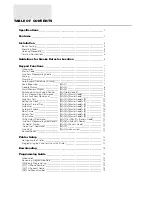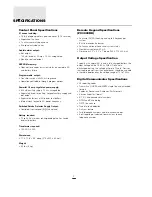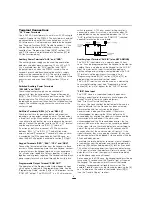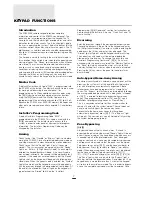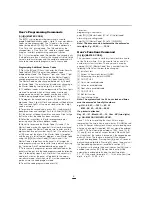
8
the bypass command is entered, pressing [99] recalls the
last zone or group of zones which was bypassed. If the
same group of zones is bypassed each time, this bypass
recall feature can be used instead of having to bypass
zones individually.
When the PC3000 is programmed, the ability to bypass
certain zones may be eliminated. In this case, the “Zone”
lights for those zones will not come on in response to the
bypass command. See the “Zone Bypass Mask” instruction
in the [
Q
][8] Installer’s programming section. If the “Bypass”
light is on when arming the panel, the [
Q
][1] command
should be used to see which zones are bypassed so that
zones are not unintentionally bypassed. Zone bypasses are
automatically cancelled when the panel is disarmed.
If light 8 in section [19] is on then a code must be entered
with [
Q
]+[1] to bypass zones. Only the zones assigned to
the same side of the system as the user code can be
bypassed. The ability to bypass using certain access codes
can be eliminated. See the “Access Bypass Mask”
instruction in the [
Q
] [8] Installer’s Programming section.
Note: At no time can any armed zone be bypassed.
Trouble Display
[Q]+[2]
The PC3000 continuously monitors a number of possible
trouble conditions. If one of these conditions occurs, the
keypad “Trouble” indicator will light and the audible
indication will sound (two short beeps every 10 seconds).
When the [#] key is pressed the audible indication will stop
but the “Trouble” indicator light will remain on until the
trouble is cleared. Trouble conditions can also be
transmitted to the monitoring station (see “Programming
Guide” sections [09] and [10] for alarm and restoral trouble
codes). Press the [
Q
] then [2] keys to display the type of
trouble. The “Zone” lights indicate the type of trouble
condition.
1 Low stand-by battery
2 AC power failure
3 Day zone trouble
4 Telephone line trouble
5 Unsuccessful communication attempt with monitoring
station
6 Bell circuit failure
7 Smoke detector zone trouble
8 Loss of time on internal clock
Press [#] to return to “Ready”.
1 Low Battery...
A battery trouble will be displayed and can
be reported if the battery is weak, disconnected or the
battery fuse is blown. Only one low battery alarm or restoral
transmission takes place per arming period. Low battery
trouble display is latching and can only be cleared by
battery restoration, arming and disarming panel then
accessing trouble indication.
2 AC Power Failure...
There is no audible annunciation on
AC power failure. The system “Trouble” light will come on but
the audible indication will not sound until there is a low
battery condition. Transmission delay can be programmed
for 1 to 99 minutes. See “Programming Guide” section [22].
3 Day Zone Trouble...
This trouble applies only to zones
which have been programmed as day zones.
(“Programming Guide” section 16 & 17). A day zone creates
a trouble signal when the panel is disarmed and an alarm
signal when the panel is armed.
4 Telephone Line Trouble...
A telephone line trouble is
generated when the line voltage drops below 3 volts for
more than 30 seconds. It generates a keypad trouble when
the system is disarmed and rings a local alarm when the
panel is armed if section [19] light 5 is off.
5 Unsuccessful Communication...
If the digital
communicator is unsuccessful communicating with the
monitoring station after eight attempts, a trouble is
generated.
If a later attempt to communicate is successful the trouble is
cleared.
6 Bell Circuit Failure...
If the bell fuse is blown or the bell
circuit is open, a keypad trouble and a trouble transmission
are generated.
7 Smoke Detector Zone Trouble...
If a FIRE zone is open
circuit, a keypad trouble and a trouble transmission are
generated. A trouble on the FIRE zone will unconditionally
initiate an audible indication on the keypad. This means that
even if any other previous trouble has been silenced, a FIRE
zone trouble will restart the keypad buzzer.
8 Loss of Internal Time...
When the PC3000 is powered up
or reset, the internal time of day clock needs to be set to the
correct time. This trouble is cleared when the trouble display
is viewed and exited or when an attempt is made to reset
the internal time of day clock. See “[
Q
][6] User’s Function
Command” for resetting time of day clock.
If the [9] is pressed while in the trouble display mode the
most recent trouble will be displayed on the zone LEDs. This
trouble memory feature is useful as a diagnostic aid when
installing and servicing the PC3000.
Alarm Memory Display
[Q]+[3]
Press [
Q
] then [3] to enter the alarm memory mode. The
“Memory” light will flash and any alarm caused during the
last armed period will be displayed on the zone lights. In
addition to the last alarm memory there are 2 history levels.
After entering the memory mode (pressing [
Q
] then [3]),
pressing [9] will cause the keypad to display the two other
levels of alarm history. Each time [9] is pressed the keypad
will beep 1, 2 or 3 times to indicate which level of history is
being viewed. When the panel is armed, the last alarm
memory is cleared and the contents moves to the 1st history
level. The “Memory” light will only be on when there was an
alarm during the last armed period.
Press [#] to return to “Ready”.
Switched Auxiliary Supply Control
[Q]+[Hold Down 4]
To interrupt the switched auxiliary power supply press [
Q
]
then hold down [4] for the desired interrupt time. When the
[4] is released the system returns to the “Ready” mode and
the switched auxiliary supply is restored.
Summary of Contents for PC3OOO
Page 1: ...INSTALLATION MANUAL PC3OOO Version 7 51...
Page 40: ...HOOKUP DIAGRAMS 36...
Page 44: ...29000543 R7...



